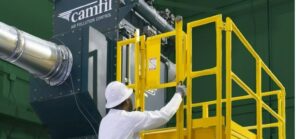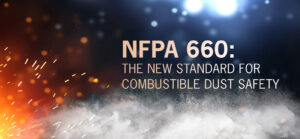Dust control is one of the most difficult challenges in industrial manufacturing and processing. Operators are challenged to meet both occupational health and environmental regulations. When properly maintained, your dust collector can keep workers safe and protect the environment. However, dust collectors require constant maintenance and one that is not properly maintained can cause an explosion or fire. Here are ten important tips for operations and engineering personnel responsible for dust collector safety:
1. Equip with Deflagration Protection
If your dust collector handles combustible dust, you must equip it with deflagration protection. Although there are many forms of passive deflagration and explosion protection, explosion vents are the most common and cost-effective method. An explosion vent opens when a predetermined amount of pressure builds up inside the collector. This enables the excess pressure and flame front to exit to a safe area. Explosion vents are designed to prevent dust collectors from blowing up in the event of a deflagration, thereby reducing the hazard. They also minimize damage to the collector itself.
2. Protect the Ductwork
Even if a collector has rugged construction and a properly sized deflagration vent, The National Fire Protection Association (NFPA) requires protection for the ductwork and safety processes upstream of the dust collector. Equip the ducting with dampers and isolation valves designed to minimize the risk of deflagration within these components. A flow-activated passive inlet isolation valve protects downstream work areas from the propagation of flame and pressure through the inlet duct when deflagration occurs in a dust collector. During deflagration in a dust collector, the pressure wave will close the valve preventing the passage of flame and smoke to areas upstream from the valve.
3. Don’t Keep Dust in the Hoppers
A dust collector's hopper should not be used to store dust. The hopper is only intended to funnel process dust to a storage bin. Dust that has accumulated in a hopper creates a potential fire or deflagration risk. Dust in the hopper may also diminish the collector's performance by clogging the system and preventing the pulse-cleaning from doing its job. Self-dumping hoppers are essential for dust collector safety because they provide easy dust disposal while protecting against unwanted dust leakage between the collector and hopper.
4. Use Pulse-Cleaning Controls
The dust collector's cleaning system design works in conjunction with filter design and is vital for dust collector safety and efficiency. Selective cleaning controls provide an easy, maintenance-friendly way to keep filters clean. Operators can select from continuous cleaning, on-demand cleaning or downtime cleaning. Click here to watch a 1-minute video explaining how pulse cleaning works.
5. Comply with Emissions Regulations
A way to measure your dust collector's emissions effectiveness is to test it according to the ANSI/ASHRAE Standard 199-2016, Method of Testing the Performance of Industrial Pulse Cleaned Dust Collectors. The test measures four key performance parameters:
- Emissions,
- Pressure drop,
- Compressed air usage
- Emission reading
6. Practice Safe Filter Change-Out
Dust collectors that require entry during service, put workers at risk and require companies to file confined space entry permits and monitor for gas. Many cartridge-style dust collectors offer easy filter change-out. Simple, quick-open heavy gauge doors can provide access to a fast cartridge change-out system that does not require entry into the collector. Look for doors that are fully reversible for access from either side and have an exclusive lock-out feature for worker safety.
7. Know When to Change Filters
A simple but important safety requirement is to change filters when airflow through the system reaches a differential pressure limit as prescribed by the manufacturer. Filter change-out is also necessary when the pressure drop across the collector is negatively affecting the ability of the system to capture dust, allowing it to escape into the facility. Some long-life cartridge filters can operate for two years or even longer between change-outs. However, for heavy dust-loading applications, filter replacement might be much more frequent.
8. Prevent Fire
For spark-generating applications, a range of features and technologies are available. These include flame retardant filter media, spark arrestors in the form of drop-out boxes, perforated screens or cyclone devices installed at collector inlets. Fire sprinkler systems may also be required with some installations.
9. Add Safety Accessories
You can further enhance dust collector safety with additional accessories. OSHA-compliant railed safety platforms and caged ladders can prevent slips and falls when workers access the collector for service. Lock-out/tag-out doors prevent injury caused by the inadvertent opening of doors during a pulsing cycle and/or exposure to hazardous dust. Where highly toxic dust is being handled, a bag-in/bag-out (BIBO) containment system may be required to isolate workers from used filters during change-out.
10. Include Safety Monitoring Filters
You might also want to equip your collector with a safety monitoring filter. This is a secondary bank of high-efficiency air filters that prevent collected dust from re-entering the workspace if there's a leak in the dust collector’s primary filtering system. A safety monitoring filter is a required component in a recirculating dust collection system that recycles air downstream of the collector.
Download this free white paper for more details about these dust collector safety tips.
 Americas
Americas 




